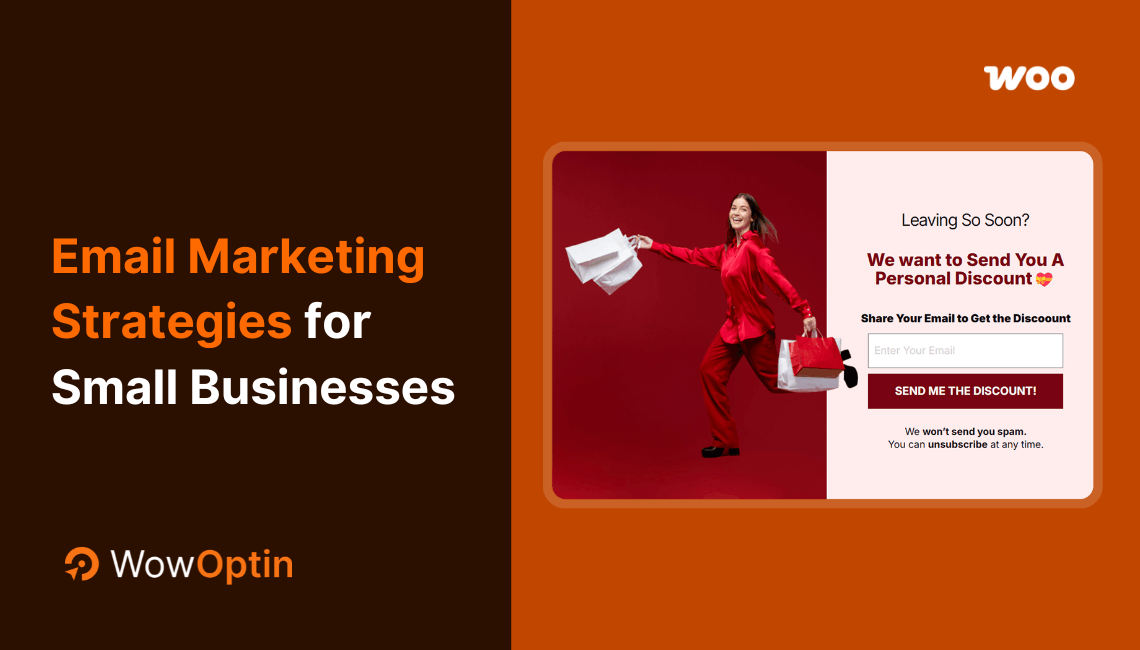Today’s discussion will be about email marketing strategies for small businesses. It will be about the potential paths to success with your email marketing efforts in business.
Let’s start with a question:
Is your small business missing out? Are you losing potential leads despite grinding and investing heavily in email marketing?
If you can run email marketing effectively, then you may:
- Get 6X better transaction rates
- Get $30 to $45 on every dollar you spend
- Enjoy better open rates of up to 40%
- See Click Through Rates (CTRs) improve by 5% or more…
Now these are just numbers.
What can you, a small business, do to get these types of numbers? How can you create a successful email strategy for your small business?
Today’s discussion is just that…we will share essential, tried, true, and tested tactics for success. You will learn about the effective practices for email marketing growth – how to collect emails effectively, how to work on relationship building with emails, and more.
Here are the key things you will find in this piece of content:
- There are 9 strategic approaches I recommend you address for crafting the perfect email marketing strategy for your business.
- Creating a high-quality email list requires targeting specific segments
- You need to craft email copies with your audience in mind
- Integrating with WowOptin helps with effective email lead collection with optimizable settings
- Email metrics are crucial for success – A/B testing is a must for the effective outcome from these metrics
🎯 Email Marketing Strategies for Small Businesses [9 Strategic Approaches You Need to Implement]
There are some email marketing strategies you should definitely know about – these are tried, true, and tested things you need to take into consideration before you get into the technicalities:
1. Your Email Marketing Goal: What Do You Want to Achieve
Before anything, you, as the business owner, need to ask yourself :
What do I want to do with the emails?
Usually, when you ask yourself this, you’ll also want to know what types of emails you’ll be sending. Furthermore, you’d want to ask yourself – what’s the purpose? What do I want to achieve with these emails? Do I want users to know about my brand? Do I want them to know about our brand? Or Do I jump on to sales?
Answers to these questions will layout the initial draft plan for your email marketing efforts. Usually what you want to do is start with emails that tell customers about your brand. Then, eventually, you’d want to move to sales focused emails.
2. Focus on Building Your Email List: Learn How!
Without a proper email list, you won’t get very far. Scaling of your business demands you to create an email list that’s dependable.
There’s a full section on how to build your email list in the next part. You’d probably want to give it a read.
3. Analytics Matters: See What’s Working and What’s Not!
Analytics tell you everything – they notify you of the performance of the emails you’ve been sending. There are a couple of key metrics you may want to keep an eye out.
Again, there’s a section in this piece of content that gives you an idea on some of the key email marketing metrics.
You need it keep an eye out for this metrics. Tracking these metrics will help A/B test and optimize your email sending strategies.
4. A/B Testing: Optimize Your Delivery
Not all ideas work – you need to perfect your emails through trail and error. A/B testing your emails and subject lines will give you insights on the things that need to change.
I wrote a section about email marketing A/B testing with Moosend. You can check it out.
5. Email Content: Try Different Things
Not every type of email content will convert – some will bring positive results. Others will simply bite the dust.
Here’s you’ll need to conduct thorough A/B testing. Also, you’ll need to customize your strategies accordingly. I’ve written a section here that’ll help with writing compelling emails. The general rules would be:
- A robust subject line
- Short, simple, and punchy email body
- A clear CTA
Focus on these and you’ll be fine.
6. Email Frequency: Test Different Strategies
The average email frequency is like 2 to 5 emails per week. However, industry-wise these numbers may vary. Here are the ‘per month‘ email frequency based on different industries:
- Flash Sale Retail: 40-52/month
- Value Retail: 20-22/month
- Mass Retail: 16/month
- Technology (B2B): 1-2/month
***These numbers can vary.
Your email frequency will depend on your target user base, email crafting capabilities, and the email metrics. So, you’ll need to be alert and keep on testing and optimizing your emails.
7. Analyze Your Competition: Get Inspired from Their Emails
Analyzing your competition will help you craft better emails. You’d want to:
- Check what type of emails their sending (I shared a list of the different types of email content you can send to your customers – give it a read).
- What’s their email sending frequency?
- What type of copy are they providing?
- What ‘special sauce’ are they using in their emails
What you want to do is take inspiration – you don’t want to copy their strategy entirely. You’d want to take the best bits, personalize them, and use them for your email marketing.
8. Email Partnerships: They can Work Wonders!
Email collaborations are a great way to tap into each others customers. It’s not about reaching ‘each others’ customers. It’s also about maintaining a strong relationship.
You’d want to collaborate with key marketing people from relevant industries to make this collaboration successful. The email collaboration must be a win-win situation for all parties.
9. Collect Emails from Multiple Channels
Your site has a ‘subscribe’ section. That’s great!
But you need to widen your reach. You need email collection points with proper CTAs on different platforms – including social media like Facebook, LinkedIn, Twitter, Instagram, etc. There’s a section here that’s going to help you.
📬How to Build a High-Quality Email List?
Building a targeted email list is essential for small businesses looking to maximize their email marketing ROI. A high-quality list ensures you’re reaching engaged subscribers. Users on this list are generally interested in your offerings – they want to learn more about them.
But before that, you need to know – what is email marketing?
In simple words, it means to ‘update’ the users (or buyers) of your products or services. It’s a digital marketing tactic that implies sending emails to folks strategically for sales promotion, awareness, lead nurturing, and more.
The next things you should know – why is email marketing beneficial for small businesses?
- Email marketing is very cost effective – return on investment is very high
- It helps turn leads into paying customers through promotional offers
- It helps drive sales and conversions
Now, let’s get back to the topic at hand – which is email list building:
Email list building for small businesses can be quite challenging – you already have minimal resources as a company. On top of that, you need to work on your email list growth – create an ‘effective’ list that’s going to give you the best results.
There are some tried and true methods for email list building. You can try the tactics below to create the perfect email list for your small business:
Website Opt-in Forms [Your First Step to Capturing High Converting Leads]
Strategically placed website opt-in forms improve lead capture – making it easier to capture potential leads. You can place these optins strategically in the following positions – these placements typically offer the best outcomes.
1. Use Opt-in Forms on Known Site Locations
- Header & Footer Sign-up Forms for Small Business Websites – These are always visible – users can easily use the forms to subscribe.
- Sidebar Newsletter Signup Forms – these are typically helpful for eCommerce websites. When you’re promoting special offers, there is a high chance of getting better sales and conversions from these placements.
- Inline Email Sign-up Forms for Blog Posts – You need to be strategic with the placement of these types of website opt-in forms. You will need to A/B test based on the email collection outcome.
- Contact Page Subscription Forms for Service-Based Businesses – Usually when someone subscribes from these types of pages, they are interested in your products or services – they want to learn more. Please
2. Use Irresistible Lead Magnets for Email Sign-ups
Lead Magnets are a great way to collect email leads. Lead magnets can be checklists, guides, e-books, white papers, etc. Here are some popular examples of lead magnets to gather fresh emails.
Here are some examples:
- You can offer a Free Social Media Content Calendar – small businesses that deal in digital products will need it badly. You can use it to get emails from small business owners who would benefit from a social media calendar.
- E-commerce Discount Strategies: Use Emails for Success – An e-book on this can be super useful for growing E-commerce store owners who are struggling to get traction in their businesses.
- Local Business Growth Checklist: How to Attract More Customers via Email – Small brick-and-mortar businesses will benefit from checklists like these. It will persuade them to subscribe to your email list.
3. Social Media Tactics for Effective Email List Growth
You should have a social media email list. This list will focus on collecting emails from social media. Here are some resource ideas you can share:
- “How to Use Instagram Bio Links for Email Sign-ups”
- “Facebook Contest Ideas for Growing Your Email List”
- “How to Run LinkedIn Ads for B2B Email List Building”
Notice that these e-books, guides, or checklists focus on email list collection from social media. If you can get the message out correctly, small business owners will likely share their emails with you.
4. Offline Email List Building for Small Business Owners
Don’t overlook offline email list-building opportunities. Events, social interactions, and meetups can be a great way to meet new people and collect emails.
If you’re running a WooCommerce store offline, you can create an in-store email signup campaign. Users who sign up can receive special discounts in-mail from your store.
WowOptin is a great option for WordPress users to gather potential email leads. It can integrate with popular email marketing tools and collect email leads – it’s the perfect tool for small businesses looking to get traction from their email marketing strategies.
📩 How to Craft Engaging Email Copies [Case Studies]
Email marketing for small businesses has two parts. 50% of it is collecting effective email leads. The other 50% is about crafting a compelling email copy.
Let’s look at some popular types of email marketing copies. These are well-known in the industry and have decent metrics across different industries.
1. Welcome Emails: It’s All about the First Impression
New subscribers like to engage more – it’s why welcome emails have a 68.59% open rate.
Take Neurogan, a wellness brand. They recreated their welcome series with user stories and personal experiences. The result? A 76% boost in revenue as a whole!
2. Abandoned Cart Emails: Lose Less Sales
People abandon carts for many reasons. However, a well-timed email can bring them back – there’s more than a 60% chance!
Envelopes.com did this brilliantly by sending friendly reminders – it led to a 40% increase in conversions—and a simple tweak led to better conversions.
These types of email are super useful for small businesses, especially E-Commerce site owners. This email marketing strategy should certainly be a part of a business’s overall e-commerce marketing strategy.
3. Promotional Emails: Send Offers at the Right Time
Draper James, a fashion brand, personalized their promo emails based on customer interests – this type of ‘personalization’ is super important to make customers feel special. And, most importantly, it works!
This approach led to a 10x increase in new customers and a big jump in repeat sales – an important pipeline to
4. Re-engagement Emails: Bringing Back the Inactive
If your subscribers stop engaging, there’s a reason for it – don’t quit on them.
A non-profit, TechSoup Polska, created a re-engagement campaign offering super helpful content. This strategy led to a massive 1200% increase in order value – in just one year!
5. Educational Emails: Selling Without Selling
Sometimes, customers don’t need a discount—they need knowledge. They look to get educated about a particular product or service.
Cafely, a coffee brand, sent beautifully crafted emails teaching customers about brewing techniques. It turned out to be exactly what the customers wanted.
The result? A 20% increase in revenue just by sharing these chunks of ‘expert emails’.
6. Exit Intent Emails
Exit Intent Emails? Why are they important?
These emails reach a customer’s inbox when a user is about to make a purchase – but somehow doesn’t complete it (the use case can be different for different users).
These types of emails can convert 30% to 50% of users to complete an action – specifically to complete a purchase. For example:
- Amazon uses these types of emails to remind users about products in their carts – it helps them reduce cart abandonments
- Based on browser behavior – Zappos sends out product recommendation emails to the users who leave their site without purchasing.
Discount codes are super helpful in this case – ASOS sends out special discount codes to users who leave without buying from their site.
📜 Writing the Perfect Copy [Crucial for Your Email Marketing Strategy]
The email types mentioned above are simply not enough to convert a lead into a paying customer. To craft the perfect email copy, you need to do the following:
1. A “Catchy” Subject Line is a Must!
✅ Keep it short, clear, and simple (40-50 characters).
✅ Create a sense of urgency – users should feel compelled (for example, “Only 24 Hours Left before The Offer Ends!)
✅ A Personal Email works best – for example, “John, your exclusive discount is waiting!”.
✅ Avoid spammy words like “FREE”, “BUY NOW” – use them only when necessary
2. First Line, First Hook, First and Only Chance!
📌 The first sentence appears in previews (especially on mobile) – it’s your first chance to impress
📌 It should be engaging – should hit a users mind. Here are a couple of examples:
- “We noticed you left something in your cart…”
- “Big news: A game-changing feature just launched!”
4. Short and Simple [It’s the Way!]
📌 People skim emails—so scannable content is what works best:
- Short paragraphs (1-2 sentences each)
- Bullet points for key takeaways
- Bold or highlight important words
For example:
🚀 What’s inside this update?
✅ New feature: Spending Goal for WooCommerce
✅ How it boosts sales
✅ A 5-minute setup guide
5. Strong CTA (Call-to-Action) – No Beating About the Bush!
✅ Use clear, focused CTAs:
- Bad: “Click Here”
- Good: “Claim Your Discount” / “Get Started Now”
✅ Place CTA above the fold (so readers see it fast).
✅ Use contrasting colors for CTA buttons (e.g., blue, green, orange).
These suggestions work in 90% of the cases. However, you need to make sure that you bring your own twist to it. That way, it’s going to be easier for you to establish your authority.
🔗 How to Integrate WowOptin into Your Email Marketing Strategy – Get Better Leads!
WowOptin could be your best friend when it comes to collecting effective leads for emails. Advanced behavior tracking of WowOptin allows you to pinpoint users and send them highly customized emails.
In this example, I will show you how to integrate with Moosend and get email leads from customers who are looking to buy from your store but somehow didn’t complete the purchase.
I’ll be using Moosend, one of the most popular email marketing automation platforms. We’ll connect it to WowRevenue and collect emails via a popup. Before we start, you can certainly check out the following video:
Installation and Activation of the WowOptin Plugin
If you’re following this example, then you need the Pro version of the WowOptin plugin to implement this. WowOptin plugin installation is like any other plugin on WordPress.
You’ll find the complete installation process in this guide.
The next step requires you to set up Moosend with WowOptin.
Integrating The Moosend Email Marketing Platform with WowOptin
Moosend is one of the most popular email marketing platforms you can use today. You need to integrate it with WowOptin for this to work.
Here’s a detailed guide written by one of our top, in-house contributors. In this guide, he explains how to integrate Moosend with WowOptin:
The short version of it is:
- Sign up to Moosend and create an email list
- Go to the Moosend settings > API
- Copy the API key
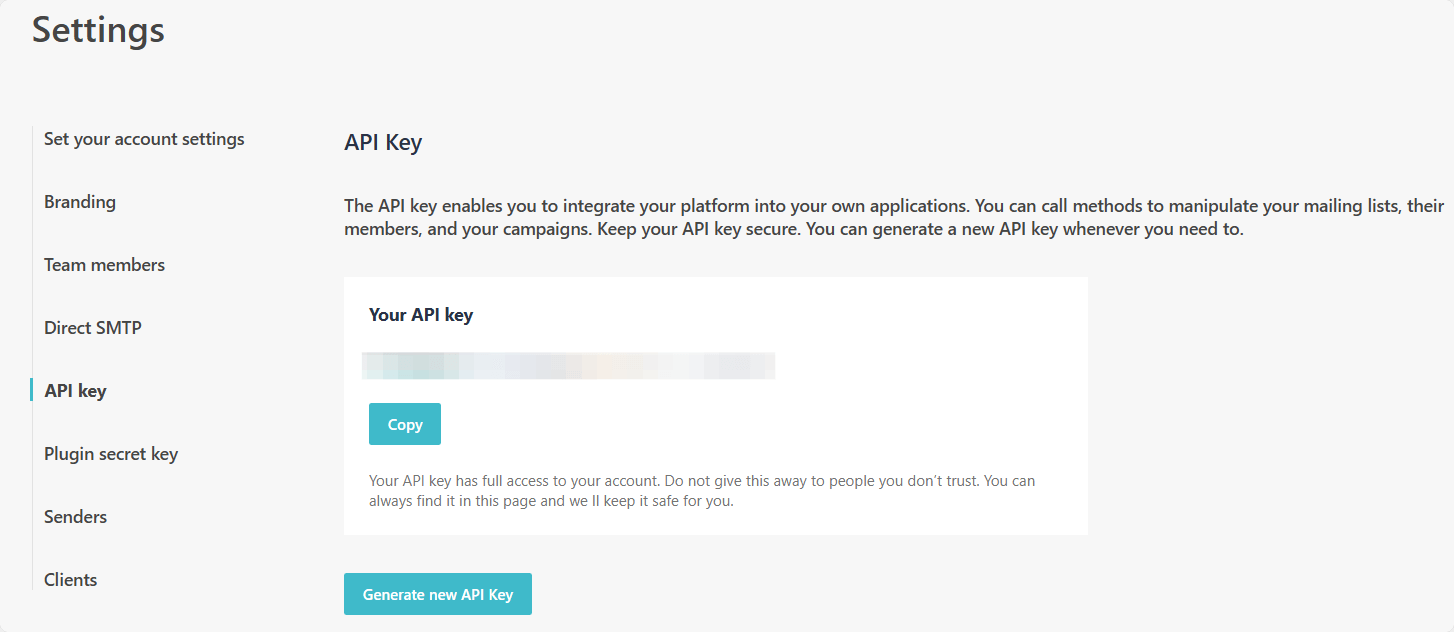
- Return to your WordPress dashboard
- Go to WowOptin > Integrations > Moosend
- Click on Manage
- In the Moosend Integration Window, select Add Account
- Now add a name and paste the API key
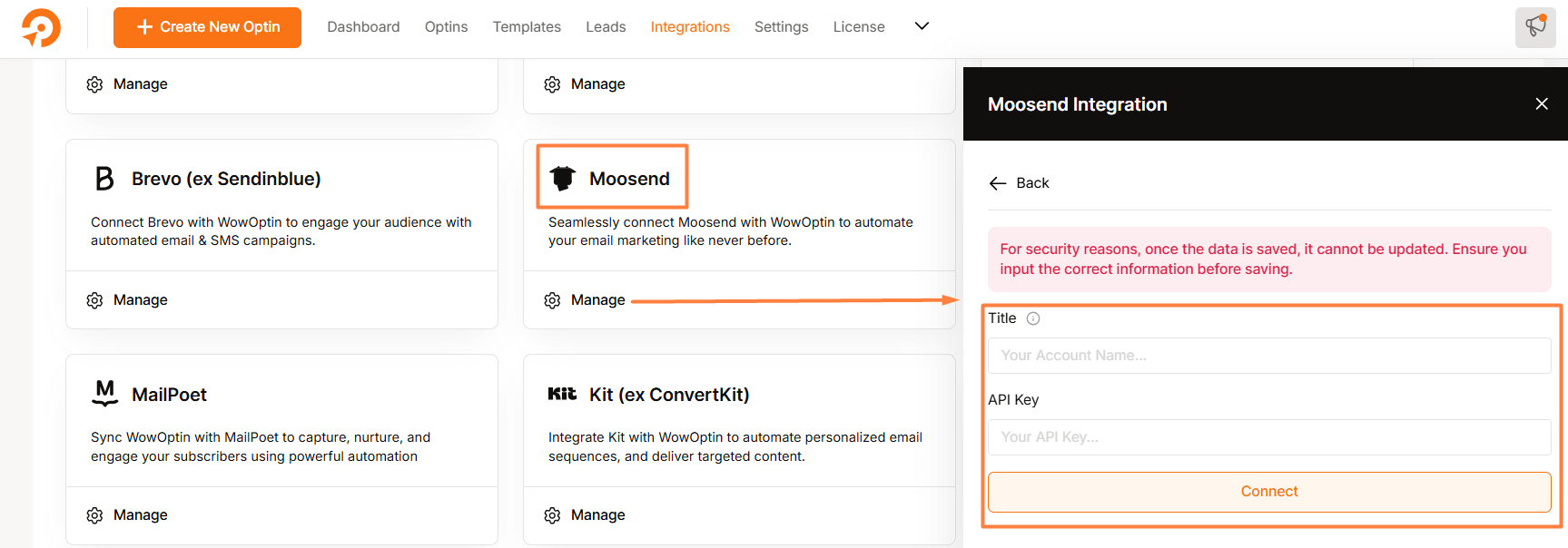
- Click on Connect
Here’s what the interface looks like when you connect your email list:
You can also add new email lists to Moosend as well.
Create the Popup for Exit Intent Email Collection
WowOptin has 2 distinct advantages in this case:
- It’s got a state-of-the-art optin builder – it’s a drag-and-drop popup builder
- There’s a wide library of templates you can use
To create a popup, you need to go to WowOptin > Optins > Create New Optin. Here you can either create a new optin or choose from one of the pre-made templates.
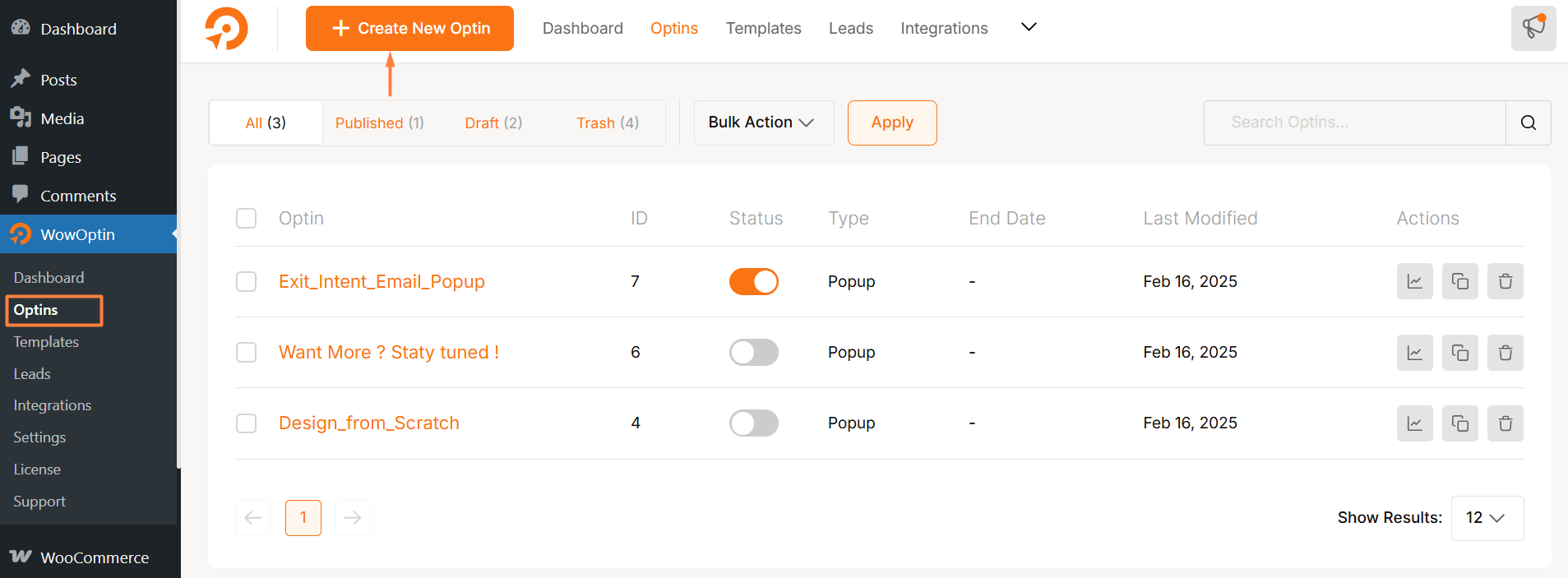
In this example, I chose one of the pre-made templates and changed the design. Although it’s not the best example, it serves the purpose. You can customize the messages using some of the examples I shared as well:
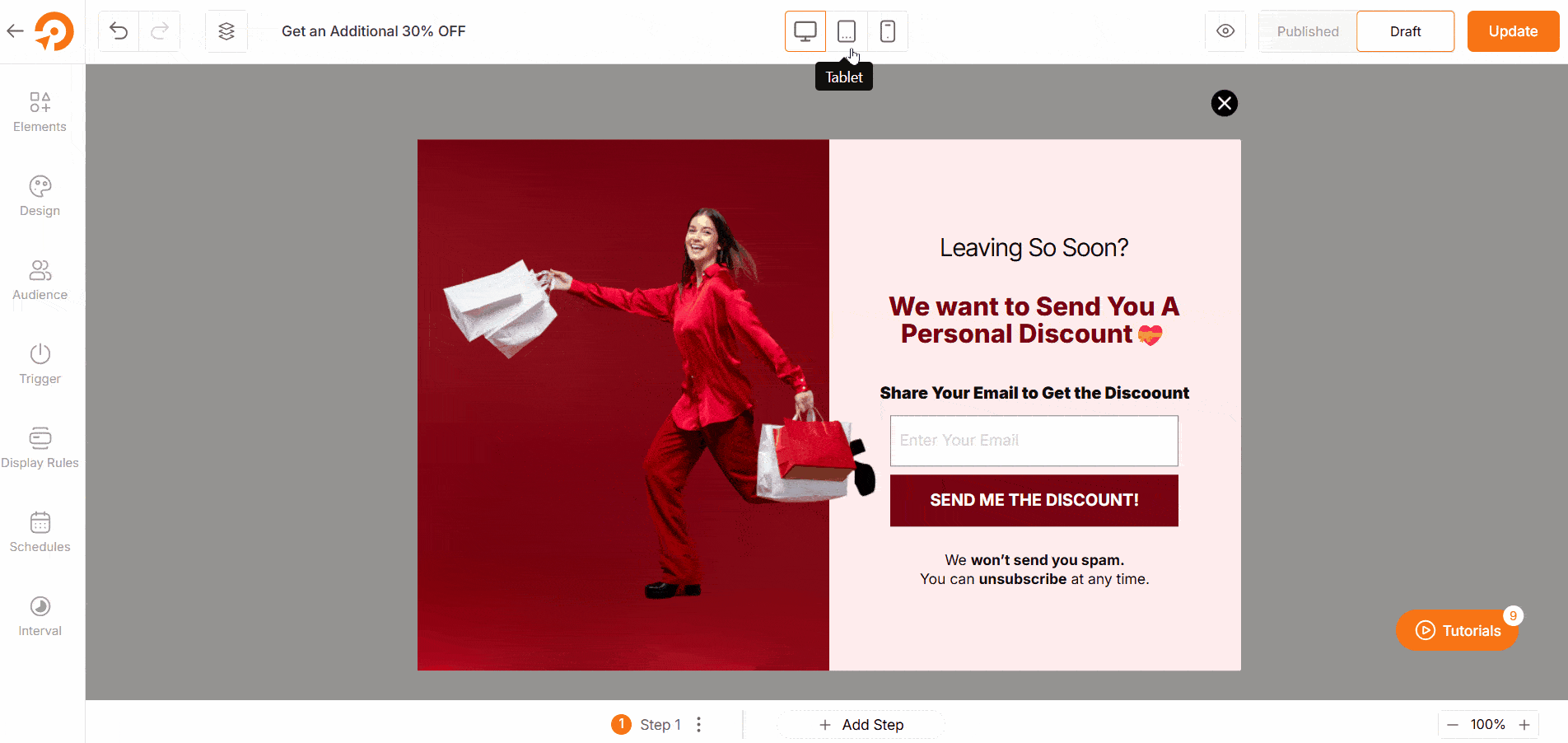
I’ve set the following (to set the targeting):
- The ‘Trigger Group’ is set to ‘Exit Intent’ with ‘Low’ sensitivity
- The ‘Display Rules’ is set to the Cart page
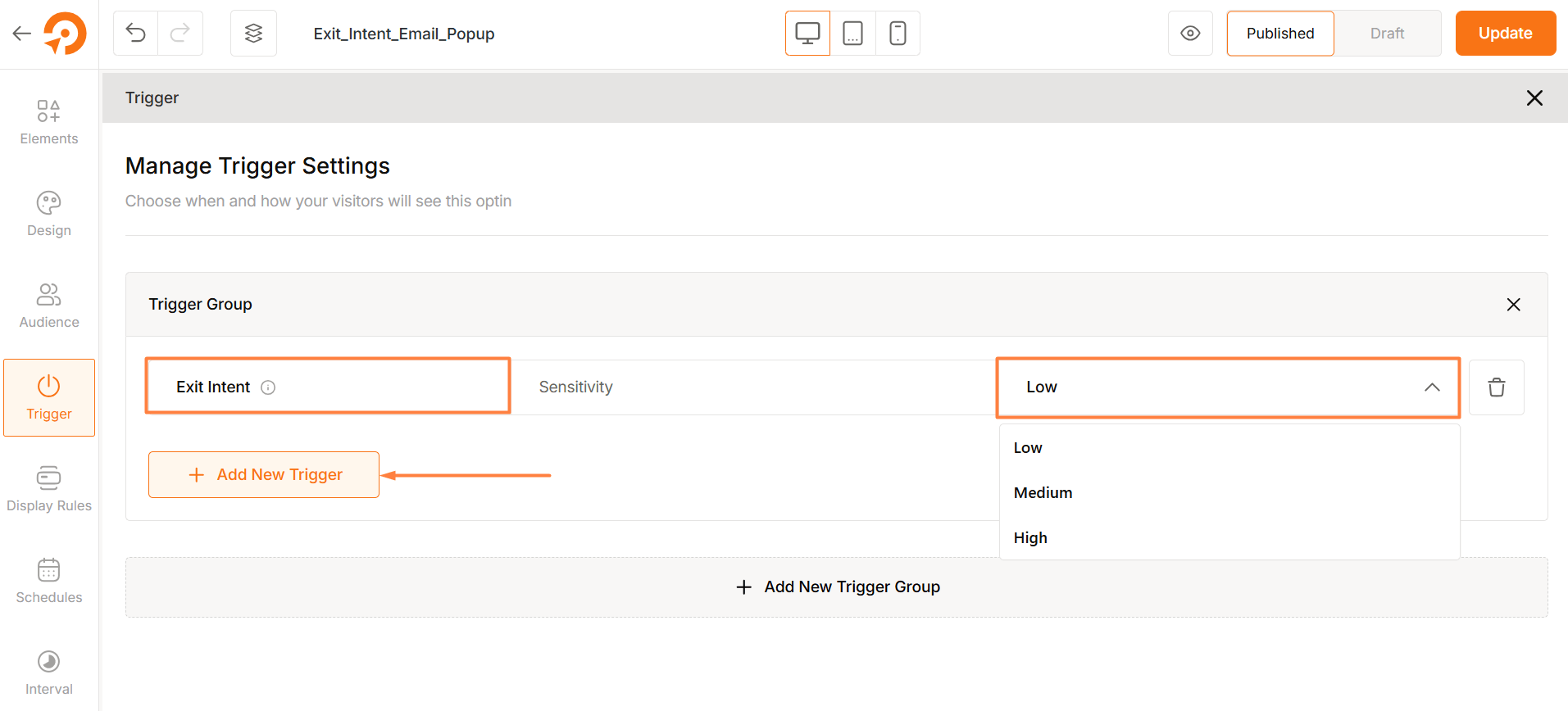
- I also changed the interval settings as well
Please note that you need to connect the Moosend integration with the relevant popup field. In this example, in the form field, you need to connect the Moosend integration:
You also need to configure the input field mapping as well.
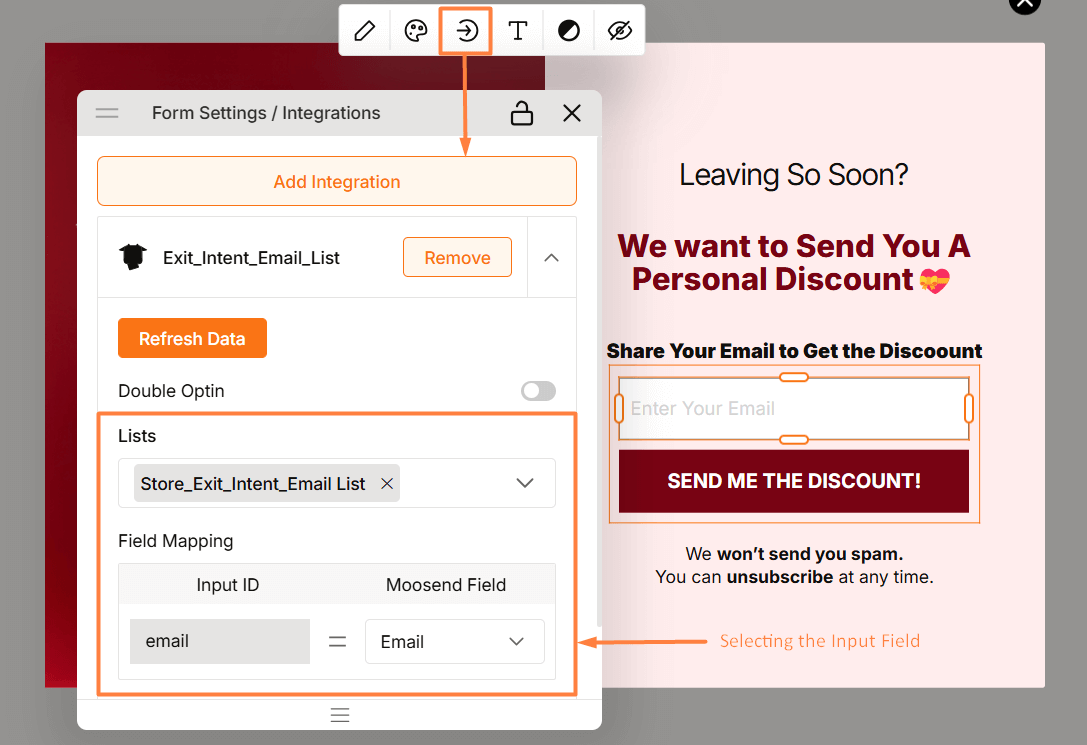
Collect Emails from the Popup
Based on the settings, if a user goes to the cart page, he or she will see the popup!
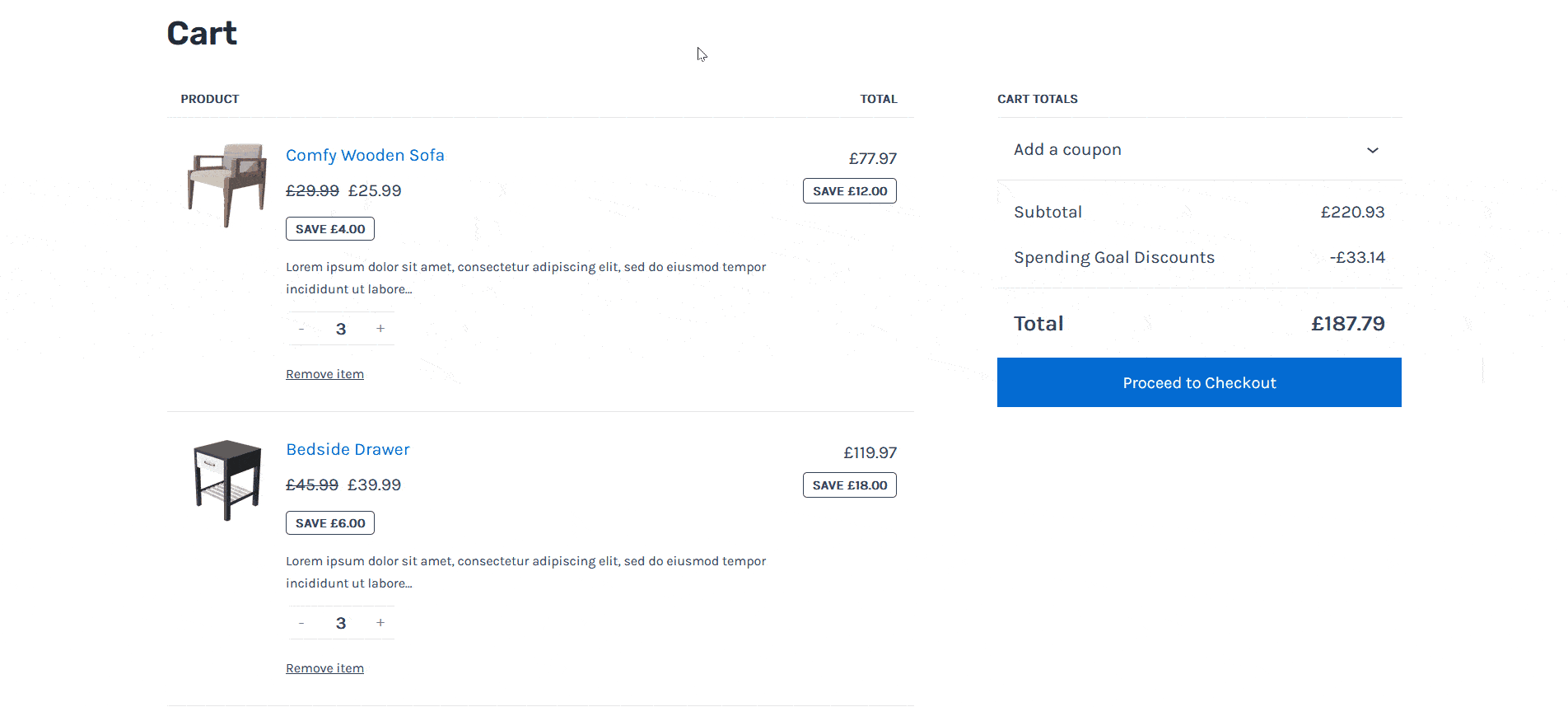
They can share their emails, and they will get added to the list.
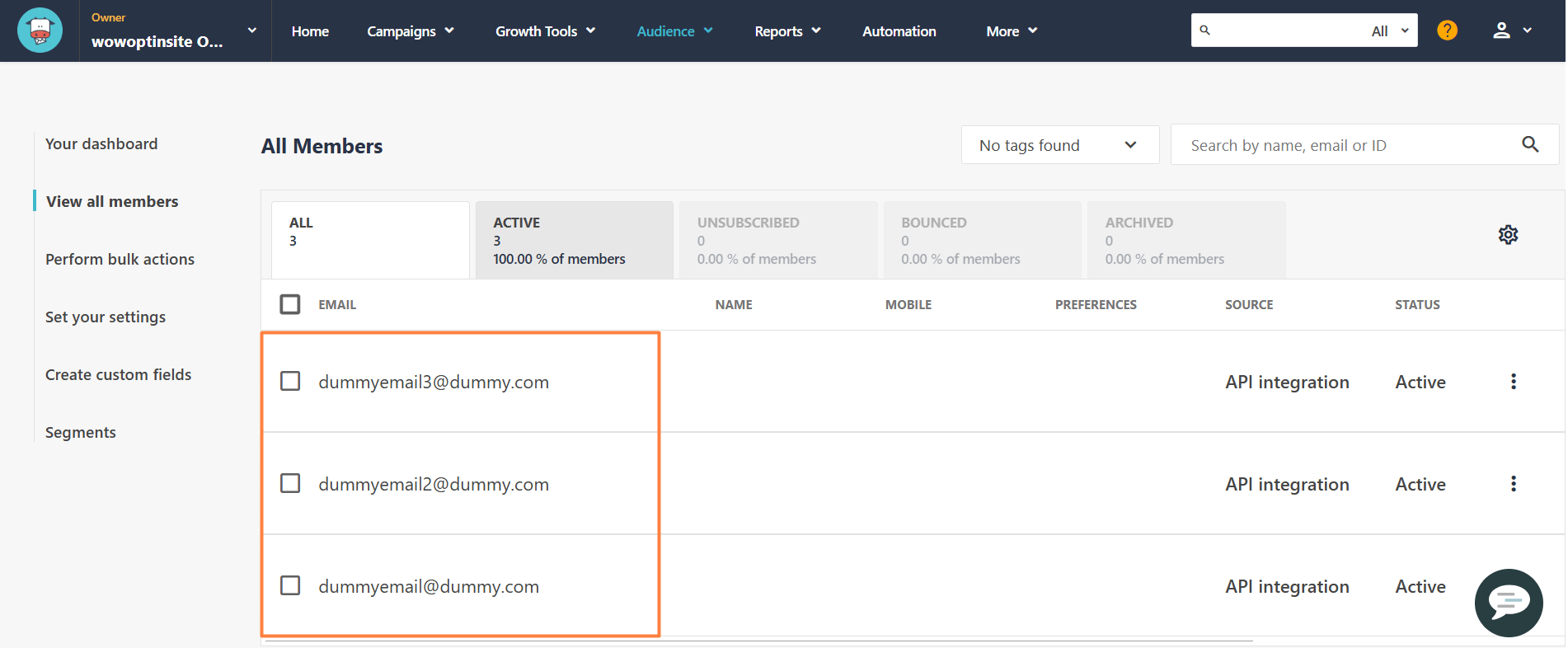
These emails will be added to the Moosend email list you created in the first place.
🏆Top 3 Email Marketing Platforms – for Effective Execution of Email Marketing Strategies for Small Business
There are some great email marketing platforms you can rely on for collecting leads using popups. Here are our top 5 email marketing platforms to use with WowOptin for effective email lead collection:
Moosend Email Marketing Platform
Moosend provides a comprehensive email marketing solution starting at $9/month, with a 30-day free trial.
This email marketing tool has (key features):
- a drag-and-drop email builder
- pre-made email templates for quick deployments
- easy landing page and form creation
- detailed analytics dashboard and more….
Moosend is ideal for eCommerce, SaaS, bloggers, agencies, and publishers, and boasts a 98% sender reputation.
And yes, it also comes as an integration with WowOptin!
MailChimp Email Marketing Tool
Mailchimp provides powerful email marketing and automation, starting at $20/month with a limited free plan.
It’s Perfect for publishers and eCommerce.
It lets you (Key Features):
- Create automated welcome series and drip campaigns
- segment your audience for effective marketing
- Leverage analytics and smart recommendations
- Built-in CRM tool for optimal marketing
If you’re simply looking for a marketing tool, then MailChimp can be an all-around solution.
And yes, if you wish to build a popup lead collection system, then MailChimp also integrates with the WowOptin popup builder plugin.
Brevo Email Marketing Tool
Brevo offers a powerful combination of email and SMS marketing, with a free plan (300 emails/day) and paid plans starting at $25/month.
It’s the perfect choice for publishers, agencies, and eCommerce.
With this email marketing tool, you get (key features):
- An easy-to-use HTML template builder
- the transactional email functionality
- landing page creating facility
It’s a proper tool for boosting web traffic and create a loyal user base.
It integrates to WowOptin as well. If you wish to collect emails effectively, via different ways, you can do it with the WowOptin+Brevo combo!
📈 Email Marketing Strategy Outcomes [Key Email Metrics to Measure]
As you’re building an email marketing strategy (and possibly creating and implementing popups to collect these emails), you need to understand the email metrics. Understanding these metrics will help you lay the groundwork, for your strategy:
- Open Rate: It measures the percentage of recipients who open your email. A high open rate indicates authority – meaning you’ve hooked the user with an appropriate subject line. Also, the user trusts your authority.
- Click-Through Rate (CTR): It shows the percentage of recipients who clicked on a link inside the email. A strong CTR can mean 2 things: First, the content of the email is great. Second, the CTR is compelling enough for the user to complete an action.
- Click-to-Open Rate (CTOR): This tracks the percentage of recipients who clicked after opening the email.
- Bounce Rate: These are the undelivered emails. Usually, there are 2 types of bounce rates – hard bounce and soft bounce. Your target would be to keep the bounce rate low – indicating that users will find your content to be trustworthy.
- Conversion Rate: It tracks the percentage of users who completed an action, such as making a purchase or signing up for a discount.
- Revenue per Email (RPE): This identifies the direct revenue generated from each email campaign, helping to find out the return on investment (ROI).
Email marketing tools can certainly help with this endeavor. However, integrating with WowOptin will definitely help. If you want to A/B test with Moosend, here’s a short description of it:
🎯 A/B Testing in Moosend: Helps identify the best-performing email variations.
- How to Set It Up:
- Go to Campaigns 👉 New Campaign 👉 A/B Split Test.
- Test different subject lines, email content, sender names, or send times.
- Split audience (e.g., 20% Version A, 20% Version B), with the winning version sent to the remaining recipients.
- Winning Criteria: Determined by open rate, click rate, or conversions.
- Testing Duration: Run for at least 24-48 hours for accurate results.
- Automation: Moosend automatically selects the best version to maximize engagement and conversions.
And, since you’re collecting the emails with WowOptin, you can check out the metrics and observe the optins performance.
Will These Email Marketing Strategies Work?
The things I shared in this discussion on “Email Marketing Strategy for Small Business” will help out with a couple of things:
- Help identify key practices
- Set up email lead collection if you’re on the WordPress platform
- Help diversify your email lead collection channels
- Know the key metrics
- Take action according the performance
- Spice up the copy through trial and error
- Understand how to run A/B tests
- Grow your email list
Is there anything we missed? Sound off in the comments below.
FAQ
What are some affordable email marketing tools?
Brevo, MailerLite, and FluentCRM are some of the best options you can try out. All of these have integrations with WowOptin.
Is Email Marketing Safe?
It’s not just safe – it’s deemed to be one of the most successful options to turn leads into effective customers.
What is the ideal email frequency?
The email frequency should be different depending on the industry. However, the average email frequency is 2-5 emails per month.
What is the ideal email open rate?
It’s somewhere around 17 to 28%. However, it will vary depending on the industry.
